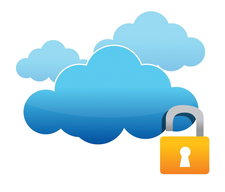Store data securely in the cloud with Cryptomator
Secure Cloud

© Lead Image © alexmillos, 123RF.com
Cloud services often place little value on data encryption. With Cryptomator, you can easily and transparently encrypt your data locally before uploading to the cloud.
Cloud services provide a convenient and cost-effective alternative to local storage, especially for users who want to access their data from anywhere. However, many cloud providers do not pay sufficient attention to data security. They often store unencrypted data in the cloud as well as transferring the data without encryption. This paves the way for hackers to sniff for authentication data to access a cloud account and then spy on the data.
State institutions, such as intelligence services or investigative authorities, can also view this unprotected data. In addition, this kind of sniffing is often legal, especially in countries where data protection is of little importance. Cryptomator [1], a program developed by the German company Skymatic, puts a stop to this data espionage by encrypting your data transparently. Since Cryptomator's source code is licensed under the GPLv3, built-in backdoors are eliminated.
Strategy
Cryptomator works as a local server that processes the data to be encrypted on a virtual drive integrated by the Filesystem in Use (FUSE) module on Linux. If FUSE is not available, the software uses WebDAV instead. Cryptomator always encrypts the data with a 256-bit AES key and a MAC master key, generating the keys using scrypt technology [2]. In contrast to many other cryptographic programs, Cryptomator not only encrypts the file contents, but also their metadata. In addition, it changes the file size, which makes it difficult to draw conclusions about a file's content.
[...]
Buy this article as PDF
(incl. VAT)
Buy Linux Magazine
Subscribe to our Linux Newsletters
Find Linux and Open Source Jobs
Subscribe to our ADMIN Newsletters
Support Our Work
Linux Magazine content is made possible with support from readers like you. Please consider contributing when you’ve found an article to be beneficial.

News
-
Parrot OS Switches to KDE Plasma Desktop
Yet another distro is making the move to the KDE Plasma desktop.
-
TUXEDO Announces Gemini 17
TUXEDO Computers has released the fourth generation of its Gemini laptop with plenty of updates.
-
Two New Distros Adopt Enlightenment
MX Moksha and AV Linux 25 join ranks with Bodhi Linux and embrace the Enlightenment desktop.
-
Solus Linux 4.8 Removes Python 2
Solus Linux 4.8 has been released with the latest Linux kernel, updated desktops, and a key removal.
-
Zorin OS 18 Hits over a Million Downloads
If you doubt Linux isn't gaining popularity, you only have to look at Zorin OS's download numbers.
-
TUXEDO Computers Scraps Snapdragon X1E-Based Laptop
Due to issues with a Snapdragon CPU, TUXEDO Computers has cancelled its plans to release a laptop based on this elite hardware.
-
Debian Unleashes Debian Libre Live
Debian Libre Live keeps your machine free of proprietary software.
-
Valve Announces Pending Release of Steam Machine
Shout it to the heavens: Steam Machine, powered by Linux, is set to arrive in 2026.
-
Happy Birthday, ADMIN Magazine!
ADMIN is celebrating its 15th anniversary with issue #90.
-
Another Linux Malware Discovered
Russian hackers use Hyper-V to hide malware within Linux virtual machines.

